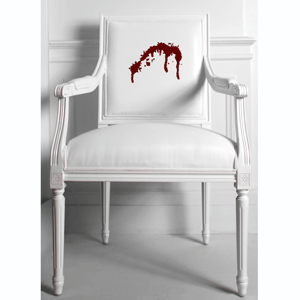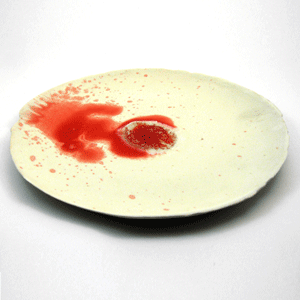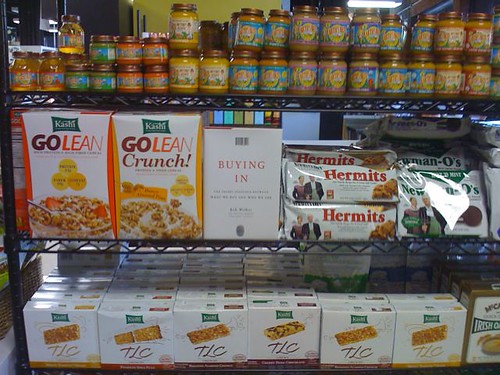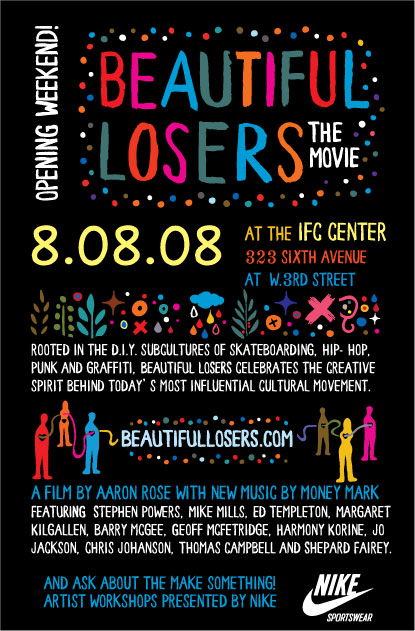Via Commercial Alert, here is an article from Ad Age about something called “The Style Series, presented by Diet Coke.” Sounds like yet another example of “branded entertainment” — ho hum! — with the mild but lately run-of-the-mill twist that “the first event streamed live via the internet, outdoor electronic billboards and mobile phones.” Ooooh! Post-television! Whatever.
Anyway, here’s the thing that caught my attention: The debut episode includes “the exclusive premiere of Rihanna’s new e-film for Gucci.”
So, let’s just get this straight. One of the featured guests on the branded entertainment post-TV program was there to tell us about her latest post-TV branded-entertainment deal?
Maybe there’s a clue in here of what Leno’s new show ought to be, or what the future of talk shows in general might look like: How about a branded show that is exclusively devoted to the touting and discussion of the latest exciting new developments in branded entertainment? Instead of stars flacking their new movies, they’ll simply discuss their latest endorsements. Indie directors will premiere the latest commercial work they’re doing to pay the bills. Reality-show stars will talk about products placed in whatever series has made them “famous.” And so on.
Very exciting to live in the “post-advertising era,” no?
I don’t know much about The Fray. But when they cut a deal with ABC, they are not kidding around. Not only did they debut their newest single on [edit: a promo for Lost during — see comments] Grey’s Anatomy (“Viewers will be directed to abc.com, where they can find a three-minute version of the clip as well as a link to iTunes; there they can buy the single, which goes to radio the next day”), Billboard reports:
The partnership between ABC and the Fray … also includes an agreement for the band to appear on the American Music Awards, “Good Morning America” and the outdoor concert series on “Jimmy Kimmel Live!” ABC will use “You Found Me” as the promo song for this season of “Lost,” and discussions are underway to use the band’s music on sister channel ESPN during the height of football season.
Wow. I guess somebody still believes network TV can move product!
[Via Songs For Soap.]
Anybody out there read the blogs on AdAge.com? Just curious.
Anyway, I was poking around that site earlier this week, and noticed a blog called “Songs for Soap,” and this entry asking “Does Every Brand Have A Sound?”
We all know that there is no longer the slightest stigma involved in a band, indie or established, renting its music to a brand, but I was still a little surprised to read just how far from those forgotten notions we’ve come: The entry concludes with the marketers actually lecturing musicians about how to make sure they’re worthy of such collaborations!
“Artists need to think of themselves as brands; what they stand for, what their values are and what message they want to give,” if they are to succeed in partnering with consumer brands.
So to turn the item’s headline around, the question for musicians, I guess, is: Does your sound have a brand? Maybe there’s a future career here — consultants who help bands write their mission statements and so on.
Anyway, for what it’s worth, this September 4, 2006 Consumed addressed Umpqua Bank’s unusual music-branding work with Rumblefish, whose founder is the first person I can remember articulating the “what does your brand sound like” pitch.
On a related note, the same blog has an entry on Girl Talk cutting a long-form ad “I’m a PC” ad. Interesting ona number of levels, and I hadn’t heard about it. (And again for what it’s worth: My July 20, 2008 column on Girl Talk.)

So I saw the chair above on Coolhunting the other day (as did plenty of other observers), and I was interested. A chair made to look blood-splattered — I would almost like to have that. But it’s pretty expensive — $5,000.
I had to read the item again to figure out the inspiration for the chair. I don’t have Showtime, and don’t know much about the show Dexter, which is about a serial killer. But that’s the inspiration.
According to this official site, Showtime and Metropolitan Home have revamped a townhouse in Gramercy Park into The Showtime House, “a beacon of modernism inspired by six Showtime original series.” That is, it’s sort of a big walk-in ad for Dexter and The L Word and Californication — you go in and just sort of bask in this aesthetic manifestation of those programs.
And if you like what you see in the Dexter Dining Room And Kitchen, well, you can buy it!
 Somehow to me this stuff becomes way less interesting when I realize it’s essentially a high-end brand extension. But maybe I’d feel differently if I were a Dexter fan. Or maybe it doesn’t matter at all — if I had the money, I might enjoy looking at that chair, or using some of the other products (the plate at left, for instance), and the Dexter factor would just fade into the background. What difference does it really make? I’m not actually sure.
Somehow to me this stuff becomes way less interesting when I realize it’s essentially a high-end brand extension. But maybe I’d feel differently if I were a Dexter fan. Or maybe it doesn’t matter at all — if I had the money, I might enjoy looking at that chair, or using some of the other products (the plate at left, for instance), and the Dexter factor would just fade into the background. What difference does it really make? I’m not actually sure.
Anyway, I also learned from the official Showtime House site that there’s actually collateral merch for all its shows, designed by Savannah College of Art and Design Students — here’s a link to the Showtime SCAD collection, but be warned that a video pops up. (I think this is separate from SCAD’s Working Class Studio). This stuff is somewhat more affordable, and some of it seems like straightforward buyable expressions fandom: T-shirts and the like.
 Other items are more ambiguous, in that (like the chairs) they might be appealing to people who don’t care about the show — the $75 Dexter pillow, for instance. (I did say somewhat more affordable; up to you whether $75 pillows are part of your budget.)
Other items are more ambiguous, in that (like the chairs) they might be appealing to people who don’t care about the show — the $75 Dexter pillow, for instance. (I did say somewhat more affordable; up to you whether $75 pillows are part of your budget.)
Anyway I think this is murkily fascinating — sort of an elevation of the promotional object into a high-design piece.
I wonder if people are buying? And how much their decision is tied to the shows that “inspired” this stuff?
Los Angeles Times on the latest in branded entertainment:
One such show, “In the Motherhood,” was recently picked up by ABC for prime-time episodes this spring, making the jump from online to TV. “In the Motherhood,” created by Santa Monica agency Science + Fiction for clients Suave beauty products and phone company Sprint, starred some medium size talent, including Leah Remini, Chelsea Handler and Jenny McCarthy. Suave and Sprint were allowed to read over scripts and “make sure it didn’t conflict with the brand,” said Anita Newton, vice president of consumer marketing at Sprint.
Science + Fiction also produced the Web series “The Rookie,” a spinoff of Fox’s “24,” for Degree deodorant. The goal for that show: take all the “brand attributes” of Degree and infuse them into the show’s main character, says Kevin Townsend, founder of Science + Fiction. That doesn’t mean that viewers will see Degree get a plug in the webisodes. Rather, the show’s main character — an intelligence operative — embodies the brand’s image of a guy who is “young, ambitious and always looking for action,” explains Townsend….
This Friday, the agency premieres a new Web series, “Fearless,” on MSN, sponsored by Hummer. The show is about five strangers navigating their way through remote locations around the world. A Hummer certainly would be handy for that.
Surely by now you’ve heard about the “integration” of GM vehicles into the new show “My Own Worst Enemy.” But just in case:
The show’s central character, played by actor Christian Slater, has two different personalities. There’s Henry, a suburban dad who drives GM’s recently launched family-oriented Traverse crossover. Then there’s Edward, a secret agent who speeds around in the new version of GM’s Camaro sports car set to go on sale early next year.
More in this story, too.
In other car-murketing news, the LA Times had this story about people hearing mysterious music in Lancaster, CA:
They all soon learned that the tune was coming from a musical road installed by Honda Motor Co. designed to play the overture when Honda Civics and other cars drove over it, as part of a marketing campaign targeting younger folks. The first musical road in the U.S. is featured in Honda commercials that began Sunday….
In Lancaster, the road attracted tourists from across the country and inspired dozens of YouTube videos, some filmed in the dark. People drove on it repeatedly to hear the noise, which sounded like the distant warbling of horns. Some even drove in reverse to see whether the song would play backward. (It did not.)…
For Honda, the possibilities of making a commercial that could also become part of the cultural moment — spreading through YouTube videos and cellphone recordings — was irresistible….
 MILK CARTOON:
MILK CARTOON:
Co-opting the kids’-entertainment-character marketing strategy for a lunchroom staple
Today, as part of a special food-themed issue of the New York Times Magazine, Consumed looks at an effort to get kids to drink more milk — by putting pop culture branded characters on the cartons.
As the Milk Media Web site puts it, “We introduced the concept of branded cartons to forge relationships between sponsors who had characters that kids really cared about as a more effective tactic to make milk ‘Cool for Kids.’ ” …
Milk has few enemies. Branding that reaches out to children inside the educational system, however, is a reliable source of outrage. …
Read the column in the October 12, 2008 issue of The New York Times Magazine, or here.
Consumed archive is here, and FAQ is here. The Times’ Consumed RSS feed is here. Consumed Facebook page is here.
To make a point about Consumed that you think readers of The Times Magazine would be interested in: “Letters should be addressed to Letters to the Editor, Magazine, The New York Times, 620 Eighth Avenue, 6th Floor, New York, N.Y. 10018. The e-mail address is magazine@nytimes.com. All letters should include the writer’s name, address and daytime telephone number. We are unable to acknowledge or return unpublished letters. Letters may be edited for length and clarity.”
Posted Under:
Consumed,
Murketing,
Sustenance
This post was written by Rob Walker on October 12, 2008
Comments Off on In The New York Times Magazine: Milk Media
Of course I was sad that New York Magazine never reviewed or otherwise acknowledged Buying In, but even so I was pleased to see they are interested in the broad topic of the murky line between commercial persuasion and culture, as evidenced by a big story on a very murketing-y topic: product integration. The writer, Emily Nussbaum, found some great examples, and makes what I think is exactly the right big-picture point:
It’s happened so gradually you may not have noticed—or, perhaps, haven’t cared. American consumers take pride in their media savvy; they are too hip to be fooled, too jaded to be appalled….
… “Most Americans, like the proverbial frogs in the slowly boiling water, may not notice how prevalent it has become. Yet Nielsen Media Research tells us that product integration has occurred more than 4,000 times on network prime-time television in 2006.”
… that proportion has risen vertiginously, jumping 39 percent in the first three months of this year versus the same time period last year. Within the top-ten broadcast-TV shows, advertisers paid for 26,000 product placements in 2007….
… And television integration is merely one ripple in a larger trend that also extends to “highbrow” art forms. In the recent revival of the musical Sweet Charity, the line “I’ll have a double Scotch on the rocks” was changed (with Neil Simon’s permission) to an order for “Cuervo Gran Centenario.”…
This is the post-TiVo click-culture counter-revolution I talk about in the middle section of the book: There’s no way to “zap past” these commercial messages, or the many others that Nussbaum collects in the piece.
Anyway, the article is definitely worth reading (and maybe it’s been highlighted already on marketing/ad blogs, but I hadn’t seen it until my physical issue of New York arrived yesterday), if nothing else, just skim through and fine the bit about Soyjoy.
And of course if you, or your friends at New York, are interested in murky forms of marketing, plenty of links, updated all the time, here.
Maybe you’ve seen it, but the WSJ has a story today about “The New Pranksters,” meaning groups like Improv Everywhere. Apart from veteran prankster Joey Skaggs cranky but funny assessment of the trend (“”There’s a lot of junk out there calling itself pranks”), the most interesting thing is the stuff toward the end about advertisers and marketers figuring out how to convert these activities into a commercial persuasion tactic:
Some advertisers are starting to see the marketing value of pranks. Taco Bell recently hired [Improv Everywhere and Urban Prankster founder Charlie] Todd to stage a “freeze” in a new restaurant in Flushing, N.Y., where paid extras posing as employees and patrons simply froze in place, baffling the actual customers. The stunt was later used in a viral marketing campaign for the restaurant’s Frutista Freeze drink, and a video of the prank has been viewed 500,000 times online, says Taco Bell spokesman Will Bortz. “We thought it was brilliant,” he says….
Recently Mr. Todd began accepting corporate sponsorships. In exchange for running a Yahoo logo on the video of his coming MP3 pranks, he says the company is paying him a fee, which he plans to use to hire a production team and possibly stage aerial shots. Mr. Todd says he’ll inform participants about Yahoo’s involvement beforehand. “If I work on a corporate thing, there’s going to be a certain percentage of my fan base who thinks it’s evil,” he says. “It’s been a very difficult thing for me to figure out.”
That’s right, AntiFriday is on Saturday today. Here goes.
* Heart asked the GOP to stop using “Barracuda” as Sarah Palin’s de facto theme song — and the GOP promptly played it again after her convention speech. “I feel completely f—ed over,” Nancy Wilson says. She and sister Ann add: “Sarah Palin’s views and values in NO WAY represent us as American women. We ask that our song ‘Barracuda’ no longer be used to promote her image. The song ‘Barracuda’ was written in the late 70s as a scathing rant against the soulless, corporate nature of the music business, particularly for women.” Slate says the GOP may not need the band’s permission.
* Unplug Your Friends features a cute video intended to counter “screen addiction.” Specifically you can counter screen addition by joining/forming a Meet Up group — or (in a classic murketing tactic) emailing your friends to get them involved in Meet Up. And I must disclose that this came to my attention because someone at Meet Up sent it to me. [Link goes straight to video]
* The Washington Post assesses retail signage that looks a lot like Barbara Kruger’s work. Guy responsible says it’s an “obvious homage.” Kruger doesn’t seem to care one way or the other. Writer Blake Gopnik concludes: “Sometimes — maybe even most of the time — the look of an image is itself the thing we care most about it. Its look is its crucial content. Its style is its meaning; it’s what gets distilled out of it, as the message we take home. When a real estate agent borrows Kruger’s look and leaves most of her ideas behind, he may be treating art the way most of us do.” [I’m a devoted WaPo Style page reader, but thanks also to Braulio for mentioning this.]
* And finally: E directs my attention to this video in which you “meet the graphic designer behind Hollywood’s most famous floating head movie posters.” Amusing. [Again, link goes straight to video.]
Posted Under:
Anti,
Artists,
Backlashing,
Murketing
This post was written by Rob Walker on September 6, 2008
Comments Off on AntiFriday: Your weekly compendium of backlashes, dissent & critiques
… mere moments after that post below, I see (via PSFK) that Urban Outfitters has “has offered a set of windows facing the Philadelphia Institute of Contemporary Art as a canvas for artists to present public installations.”
Something’s Hidden In Here has taken the retailer up on this offer, with a project called Your Message Here.
Basically they have installed a sign in said window, and are inviting you — yes you — to make suggestions for what it should say. Apparently they’ll change it daily. Maybe a line from that Guardian piece (“Adverts are the enemy of art”) would be interesting? I don’t know. Maybe this project is an example of art and commerce coexisting happily. What do you think?
If you care to suggest something to be put on the sign, go here, and type away. As I bang this out you have 160 competitors and counting.
Maybe this should wait till AntiFriday, but …
Via ArtsJournal, here’s Mark Ravenhill in The Guardian:
Recently, I became excited about the possibilities of creating a drama serial on the internet: thrice-daily instalments in a fresh medium. But I quickly discovered that the only source of funding lay in business. There are no ad breaks in internet drama. If money is forthcoming, the only option, at the moment, is for the drama and the advert to become one. Current internet dramas are funded by – and feature characters prominently using – a particular type of mobile phone or sanitary towel. The drama’s hero, driving the action of the scene and determining the final cut, becomes the product, not the character.
If this is the only choice available, then I figure, as a dramatist, it’s best to walk away.
 I’m on a deadline today and both too busy and too cranky to come up with something current and original. So meanwhile, this: Some months ago I bookmarked this item (via Commercial Alert):
I’m on a deadline today and both too busy and too cranky to come up with something current and original. So meanwhile, this: Some months ago I bookmarked this item (via Commercial Alert):
Build-A Bear Workshop is teaming up with Milk Rocks to feature its virtual world, BuildaBearville.com, on 120 million milk cartons in 95,000 elementary schools.
Each milk carton will include facts about the site and a code for a free virtual milk carton….
The campaign is designed to be a fun way to promote health and nutrition and to encourage kids to drink milk, Build-A-Bear Workshop said….
Etc.
It caught my eye because I once wrote about Build-A-Bear, and have written about virtual worlds several times. But I bookmarked it because I was curious about Milk Rocks. This seems to be an offshoot of Milk Media, which bills itself as “a pioneer in communicating with elementary, middle, and high school students.”
According to its about page, it started 10 years ago. Back then, dairies were using “self-created characters” on their packaging for the school market to promote their “pro-milk messages.” Milk Media “introduced the concept of branded cartons to forge relationships between sponsors who had characters that kids really cared about as a more effective tactic to make milk ‘Cool for Kids’.” The company says milk consumption in schools using its carts with characters such as Batman and Disney’s Doug is up 34%.
Next up came Milk Rocks, which involves a lot of pop celebrity tie-ins, and this video-loaded website, but which I frankly don’t understand.
I gather the overriding goal is to get kids to drink more milk by associating it with “cool” stuff.
I also assume that the motive for Build A Bear, or an participating brand owner or pop star is, on some level, self promotion. I mean, come on, getting our name/brand onto millions of milk cartons in schools, that’s a big deal, right? (Milk Media itself says it is “the ideal way to reach millions of students K-12 with a core target demographic of tweens and teens (ages 10-18).”
Clearly, this is not new. But what do you think of it? Noble? Creepy? Both?

If you want to get a pic in the Murketing Flickr group highlighted here on Murketing.com, this is a) cheating, and b) encouraged.
Save

I’m happy that the Beautiful Losers documentary is getting plenty of attention, and I look forward to seeing it. I’m a fan of many of the artists who I gather are in it, and I both like and respect Aaron Rose. He is interviewed in the current issue of Complex talking about a spinoff project: “Make Something!! Workshops,” and I like the sound of these, too. The film’s site says:
Working with public school art programs and youth mentoring programs, MAKE SOMETHING!! will invite local children to participate in creative workshops such as sign painting, photography, skateboard graphic design, toy design, filmmaking, tattoo art, footwear design and zine making.
Workshops will be hosted by renowned artists from the Beautiful Losers “do-it-yourself” art subculture, which include Ed Templeton, Tobin Yelland, Geoff McFetridge, Shepard Fairey, Mike Mills, Todd James, Cheryl Dunn, Kaws, Mr. Cartoon and Aaron Rose. The work created in each location will form a continually evolving exhibition, which will be open to the public to view.
Sounds good.
And yet … despite all my good vibes about this … I must say that my reaction to the version of the movie poster above was: What’s the swoosh doing on there?
These workshops, apparently, are courtesy of Nike. Was that really necessary? “Make something” is obviously a fine message — but to me the whole idea of doing-it-yourself kind of loses its oomph if the doing has to happen under the auspices of the almighty swoosh. After all, did the various artists and creators celebrated in the film have to rely on a multinational to learn to express themselves? I think not. On the film’s site, the tab for this project is simply “Nike Workshops.” Ew.
I think this a bad move on Nike’s part — if Swoosh Inc. wants to do something good for the kids, then just do it (to borrow a phrase) and for once keep your logo to yourself.
I also just think it’s, you know, a general all-around bummer.
Not that any of this will stop me from seeing the doc. In fact I wish I could make it to the U.S. premier, in New York City, tonight.




 "
"



 MILK CARTOON:
MILK CARTOON:














 Kim Fellner's book
Kim Fellner's book  A
A